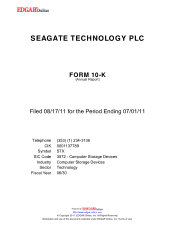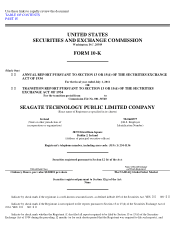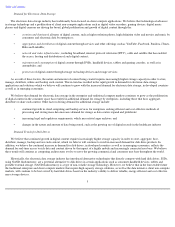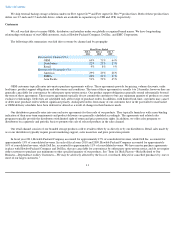Seagate 2010 Annual Report Download - page 8
Download and view the complete annual report
Please find page 8 of the 2010 Seagate annual report below. You can navigate through the pages in the report by either clicking on the pages listed below, or by using the keyword search tool below to find specific information within the annual report.
Table of Contents
Demand for Electronic Data Storage
The electronic data storage industry has traditionally been focused on client compute applications. We believe that technological advances
in storage technology and a proliferation of client non-compute applications such as digital video recorders, gaming devices, digital music
players and digital cameras are driving the broad, global proliferation and growth of digital content through the:
• creation and sharing of all types of digital content, such as high-
resolution photos, high definition video and movies and music by
consumers and electronic data by enterprises;
•
aggregation and distribution
of digital content through services and other offerings such as YouTube, Facebook, Pandora, iTunes,
Hulu and LinkedIn;
• network and video infrastructure , including broadband, internet protocol television (IPTV), cable and satellite that has enabled
the access, hosting and distribution of such digital content;
• enjoyment and consumption of digital content through DVRs, handheld devices, tablets and gaming consoles, as well as in
automobiles; and
•
protection
of digital content through storage on backup devices and storage services.
As a result of these factors, the nature and amount of content being created requires increasingly higher storage capacity in order to store,
manage, distribute, utilize and backup such content. This in turn has resulted in the rapid growth in demand for electronic data storage
applications and solutions which we believe will continue to grow with the increased demand for electronic data storage, in developed countries
as well as in emerging economies.
We believe that demand for electronic data storage in the enterprise and traditional compute markets continues to grow as the proliferation
of digital content in the consumer space has resulted in additional demand for storage by enterprises, including those that host, aggregate,
distribute or share such content. Other factors driving demand for additional storage include:
•
continued growth in cloud computing and backup services for enterprises seeking efficient and cost
-
effective methods of
processing and storing mass data increases demand for storage as data centers expand and proliferate;
• increasing legal and regulatory requirements, which necessitate larger archives; and
•
changes in the nature and amount of data being stored, such as the growing use of digital records in the healthcare industry
Demand Trends for Disk Drives
We believe that continued growth in digital content requires increasingly higher storage capacity in order to store, aggregate, host,
distribute, manage, backup and use such content, which we believe will continue to result in increased demand for disk drive products. In
addition, we believe the continued increase in demand for disk drives, in developed countries as well as in emerging economies, reflects the
demand for real-time access to rich data and content driven by the impact of a highly mobile and increasingly connected user base. We believe
these trends will continue as computing architectures evolve to serve the growing commercial and consumer user base throughout the world.
Historically, the electronic data storage industry has introduced alternative technologies that directly compete with hard disk drives. SSDs,
using NAND flash memory, are a potential alternative to disk drives in certain applications such as consumer handheld devices, tablets and
portable external storage. NAND flash memory is a type of non-volatile storage technology. However, we believe that in the foreseeable future
the traditional enterprise and client compute markets that require high capacity storage solutions, as well as the data intensive client non-
compute
markets, will continue to be best served by hard disk drives based on the industry's ability to deliver reliable, energy efficient and cost effective
mass storage devices.
5





















